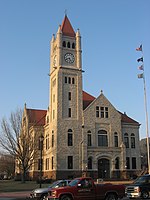Greene County, Ohio
1803 establishments in OhioGreene County, OhioOhio countiesPages with non-numeric formatnum argumentsPopulated places established in 1803 ... and 1 more
Use mdy dates from December 2021

Greene County is located in the southwestern portion of Ohio. As of the 2020 census, the population was 167,966. Its county seat is Xenia and its largest city is Beavercreek. The county was established on March 24, 1803 and named for General Nathanael Greene, an officer in the Revolutionary War. Greene County is part of the Dayton, OH Metropolitan Statistical Area.
Excerpt from the Wikipedia article Greene County, Ohio (License: CC BY-SA 3.0, Authors, Images).Greene County, Ohio
Old United States Highway 35, Xenia
Geographical coordinates (GPS) Address Nearby Places Show on map
Geographical coordinates (GPS)
| Latitude | Longitude |
|---|---|
| N 39.69 ° | E -83.89 ° |
Address
Old United States Highway 35
Old United States Highway 35
45384 Xenia
Ohio, United States
Open on Google Maps








